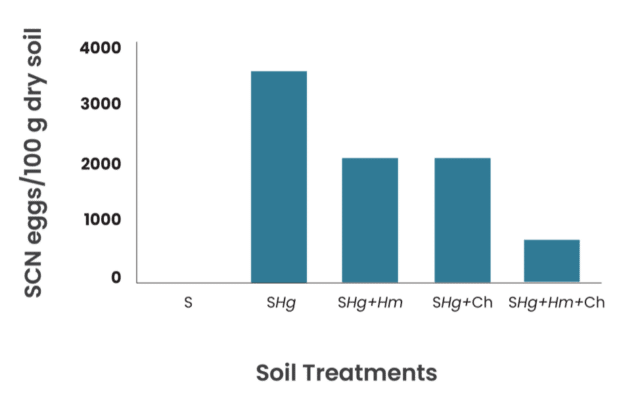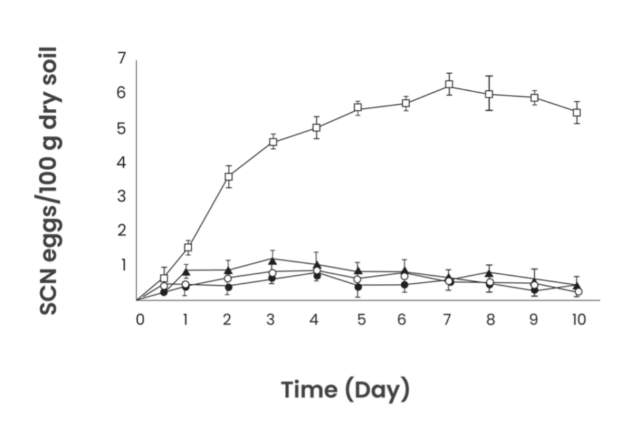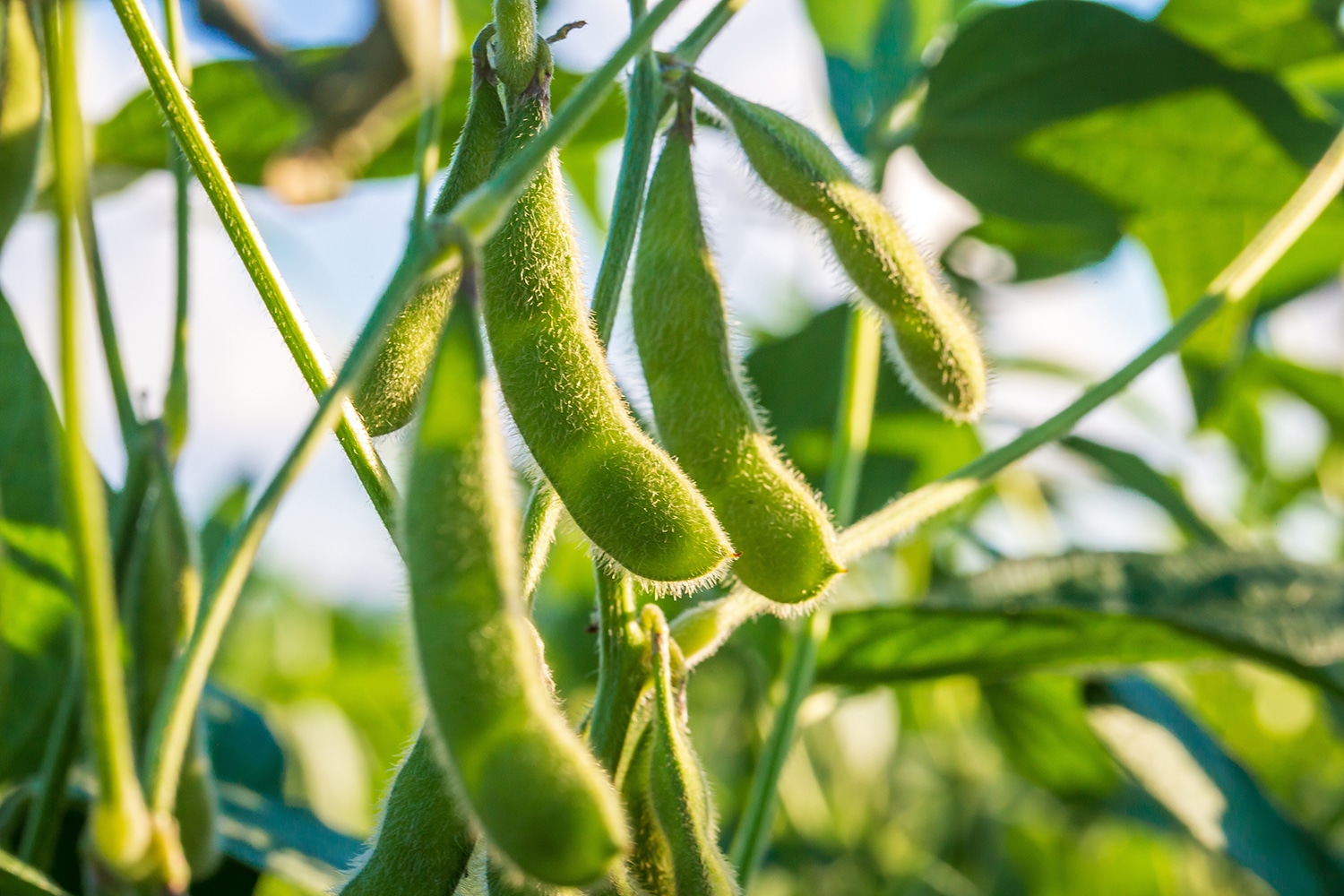Improving yield and resilience through innovative soybean crop protection
Growers understand that optimizing crop yield extends far beyond what is visible above the soil surface. The true complexity of crop health unfolds beneath the ground, where unseen threats undermine a crop’s full potential. Two of the most serious and pervasive threats to soybean crops are Soybean Cyst Nematodes (SCN) and Sudden Death Syndrome (SDS). These subterranean adversaries work quietly, eroding plant vitality, degrading root structures, and ultimately inflicting substantial damage on both the health and profitability of the crops.
SCN are microscopic parasitic roundworms that create wounds in the roots of soybeans, giving pathogens like SDS easy entry points. SCN further weaken the plant and magnify the damage by adding stress to the plant root system. With these entry wounds, fungal infections like SDS thrive, creating a devastating synergy that can destroy entire soybean fields if left unmanaged.
SDS is caused by the soil-borne fungal pathogen Fusarium virguliforme, which invades the roots and lower stem of soybean plants early in the growing season. It is a silent invader, working undetected below the surface. As the fungus spreads, it weakens the plant’s foundation, directly affecting its ability to absorb nutrients and water while severely impacting growth and yield potential.
The combined impact of SCN and SDS can impair a crop’s yield potential. For growers, distributors, seed companies, and the retailers who serve them, finding solutions that address both threats is imperative. Sustained profitability hinges on having an effective strategy that mitigates the dual dangers of SCN and SDS, ensuring that soybean crops remain healthy and productive across the entire growing season and into the future.
Read on for a new approach through seed treatment that protects your crops and elicits an immune response from pest and pathogen pressures like SCN and SDS.
What are soybean cyst nematodes (SCN), and why are they a major threat to soybean crops?
SCN are the most damaging pests that invade and colonize the roots of soybean crops.SCN feed on the plant’s roots, steadily impairing the plant’s ability to absorb essential water and nutrients. This damage creates additional stress on the plant, reducing its vigor and making it more susceptible to diseases like SDS. The dual onslaught of SCN and SDS can be detrimental for growers, often resulting in catastrophic yield losses if not properly managed.
Soybean crop stages and how SCN impact them:
SCN begin an attack on the roots of the soybean plant during the early stages of growth. This is the most critical time for root development and overall plant health.
As SCN weaken the plant’s root system during mid-season, the soybean crop is left vulnerable to fungal infections like SDS, which thrives in stressed plants with compromised roots. The presence of SCN also makes it harder for the plant to recover from other abiotic stressors, such as drought or extreme temperatures.
Symptoms of SCN damage in soybean crops:
- Stunted plant growth and reduced vigor
- Yellowing of leaves or interveinal chlorosis
- Poor pod development and reduced seed quality
- Visible cysts or galls on roots
- Patchy areas of poor yield within a field
By the time SCN and SDS have worked together to infect a crop in its late stages, the damage is irreversible, leading to poor seed quality, stunted growth, and significantly reduced yields. The solution lies in sourcing innovations that target both SCN and SDS while bolstering overall plant health and resilience throughout the soybean crop duration.
What is sudden death syndrom (SDS), and how does it impact soybean crops?
SDS is a destructive fungal disease that affects soybean crops, causing severe reductions in both yield and overall plant health. It often goes unnoticed until symptoms begin to appear later in the soybean growth stages. But by then, the damage is already done. SDS begins its assault early in the season, infecting the plant’s roots and slowly working its way up. The fungus responsible for SDS thrives in cool, wet soil conditions and is often exacerbated by the presence of SCN. As such, early planting in cooler climates can increase the risk of infection.
Leaf symptoms:
The first visible signs of SDS typically appear above ground in late July or early August during the reproductive growth stage when plants are at their peak. Symptoms often begin as scattered, yellow spots between the leaf veins. These initial signs may seem subtle, but they indicate that the fungus is already active within the plant and silently compromising its health. Growers who notice these symptoms should act quickly to prevent further damage. Early management can save up to 3.5 bushels of soybean seed per acre in a week.
As SDS advances, the yellow spots expand into brown lesions on the leaves. This progression can lead to the detachment of leaves from the petioles, significantly reducing the plant’s ability to photosynthesize. Without the ability to produce energy efficiently, the plant enters a rapid state of decline, further reducing yield potential. This is especially problematic during critical soybean crop stages when the plant’s energy demands are highest.
Root and stem symptoms:
Below the surface, the damage is equally severe. The vascular tissue in the lower stem becomes discolored, showing signs of fungal invasion. However, a key diagnostic feature of SDS is that the pith—the central tissue inside the stem—remains white. This feature distinguishes SDS from Brown Stem Rot (BSR), another common soybean disease. Accurate diagnosis is necessary for taking the right management steps and applying the appropriate treatments.
In moist conditions, SDS can also cause blue fungal growth on the roots, a clear sign of infection. This fungal invasion compromises the plant’s ability to absorb essential nutrients and water. As a result, the plant’s overall health declines, leading to stunted growth, poor pod development, and reduced seed quality. The damage caused to the roots is often permanent, meaning the plant cannot recover even if favorable conditions return later in the season.
Recognizing these symptoms early gives growers a fighting chance to mitigate the damage. Early detection allows for targeted treatment for SDS in soybeans, which can help reduce the severity of the infection and limit its spread to other plants in the field. For seed companies and distributors, it’s crucial to educate customers on the importance of monitoring crops for these early warning signs.
GENMAX®: a revolutionary seed treatment for SCN and SDS
To combat the dual threat of SCN and SDS, among other pests and pathogens, growers need solutions that target both pests and pathogens—while also strengthening the overall health of the plant. Tidal Grow® GENMAX® is a groundbreaking, scientifically advanced seed treatment that provides exactly that. Its biologically based, non-living formulation acts as a versatile and powerful tool for protecting soybean crops, improving yields, and boosting long-term profitability for growers.
What is GENMAX Seed Treatment?
The key to GENMAX’s innovation is its precisely formulated chitosan, a naturally occurring biopolymer derived from crustacean shells. Leveraging chitosan, GENMAX is an eco-friendly scientific advancement offering growers a natural, sustainable way to protect their crops from SCN and SDS. While chitosan is used across a wide array of industries, it is emerging as one of the most powerful solutions in agriculture. Beyond its biodegradable nature, GENMAX is proven to stimulate better germination, seedling emergence, and early shoot and root growth.
Mode of action
GENMAX seed treatment works in two critical ways:
1. Protects crops from harmful pests and pathogens, like nematodes and fungi
It works by forming a protective barrier around the plant’s roots, preventing pathogens such as SCN and SDS from taking hold. By addressing these threats at the root level, GENMAX greatly reduces the risk of infection and protects soybeans from the severe damage caused by both nematodes and fungal pathogens. Preventative approaches like this are pivotal for maintaining plant health throughout the growing season.
2. Elicits plant immune response
In parallel to its pathogen-blocking capabilities, GENMAX fortifies the plant’s natural defenses. It stimulates the plant’s immune response, increasing its tolerance to abiotic stressors such as drought, extreme temperatures, and wet soil conditions. Crops can better thrive and produce more consistent yields with this added resilience, even under fluctuating environmental pressures.
Key benefits and applications
GENMAX provides several key benefits and practical applications that make it a highly valuable solution for growers. First and foremost, it boasts an ultra-low use rate of (0.1 fl oz/CWT) for maximized results. This makes GENMAX a highly efficient and cost-effective solution that also sharpens other seed treatments.
GENMAX also seamlessly integrates with existing seed treatment programs. Its compatibility with other seed treatments provides the ability to reinforce their current strategies without requiring any major adjustments or overhauls. Being compatible with other seed treatments or enhancements makes it an easy and practical option for improving both yield and soybean crop protection.
As a result, GENMAX delivers a strong ROI for growers. By stimulating early root and seedling development, it enhances overall plant growth, leading to healthier and more resilient crops. The improved vitality allows soybean plants to better withstand biotic stressors such as pathogens, and abiotic challenges like extreme environmental conditions. The result is a stronger, more adaptable crop that thrives even in less-than-ideal growing environments, ultimately increasing yield potential and improving plant health.
Chitosan as a solution for SCN and SDS
The development of GENMAX is based on research into the benefits of chitosan for managing both SCN and SDS. Multiple scientific studies have demonstrated the effectiveness of improving crops, making it a powerful solution for growers looking to protect their crops and increase their profitability.
Research on SCN control with chitosan
In a 2017 study, researchers found that chitosan, when combined with the nematophagous fungus Hirsutella minnesotensis, provided synergistic control of SCN. It reduced nematode egg counts by an impressive 90% and points to a highly effective solution for controlling one of the most pervasive threats to soybean crops.

Research on sudden death syndrome control with chitosan
A 2007 study revealed that chitosan can suppress the fungal pathogen responsible for SDS. The study showed that when chitosan was applied to soybean plants, it significantly reduced fungal growth, preventing the pathogen from taking hold and causing damage. It resulted in healthier root systems and improved overall soybean plant growth.

Not all chitosan is created equal
While research suggests chitosan’s impact on protecting against pests and pathogens, it’s important to note that chitosan has several uses across industries beyond agriculture. Chitosan formulations can vary widely, and, if not formulated properly, can conversely promote pest and pathogen pressure. Simply using any chitosan-based product will not produce the same results. GENMAX is precisely formulated to maximize the impact and efficacy.
Cost-effectiveness
GENMAX is a superior SCN and SDS treatment that is at or below the cost of traditional options. With its ultra-low use rate, growers can achieve effective protection without needing large volumes of product. Reducing the risk of major crop losses, GENMAX further maximizes ROI and ensures growers can protect their crops while keeping costs under control.
At Tidal Grow AgriScience, we aim to support growers in cultivating healthy crops for today, tomorrow, the next century, and beyond by preserving the natural balance of the soil for future generations. With our technology powering products like GENMAX, we unlock higher yields and improve crop input effectiveness, from nitrogen management to advanced fungicides and nematicides. By choosing GENMAX, growers invest in a future where environmental stewardship meets innovation and maximum productivity, fostering both prosperous farms and a healthier planet.
Key takeaways
In conclusion, safeguarding soybean crops from the devastating impacts of SCN and SDS requires an integrated approach that boosts plant health and ensures long-term sustainability. GENMAX, with its innovative chitosan-based formulation, equips growers with an advanced solution for improving yield, protecting crops, and contributing to sustainable farming practices. By addressing pathogens and enhancing root and plant resilience, GENMAX provides the all-encompassing solution growers need for a successful growing season.
Key benefits of GENMAX:
- Effectively protects against pests and pathogens, like SCN and SDS
- Improves germination rates and overall plant resilience
- Integrates seamlessly with existing seed treatment programs
- Offers an ultra-low, cost-effective application rate
Ready to invest in the future of farming? Try GENMAX today and join the movement toward healthier crops and higher yields. Your farm—and the planet—will thank you!
Citations
Crop Protection Network. (2024, March 14). Soybean disease loss estimates from the United States and Ontario, Canada — 2023. Retrieved from https://cropprotectionnetwork.org/publications/soybean-disease-loss-estimates-from-the-united-states-and-ontario-canada-2023
Iowa State University. (n.d.). Quantifying soybean yield losses due to sudden death syndrome (SDS). Retrieved from https://www.ipm.iastate.edu/announcements/quantifying-soybean-yield-losses-due-sudden-death-syndrome-sds
Iowa State University. (n.d.). SCN management in Iowa [PDF file]. Retrieved from https://scn.plantpath.iastate.edu/files/inline-files/SCN_Management_0.pdf
Mwaheb, M., Hussain, M., Tian, J., Zhang, X., Hamid, M., El-Kassimi, N., … & Liu, X. (2017). Synergetic suppression of soybean cyst nematodes by chitosan and Hirsutella minnesotensis via the assembly of the soybean rhizosphere microbial communities. Biological Control, 115, 85-94. https://doi.org/10.1016/j.biocontrol.2017.09.003
Prapagdee, B., Kotchadat, K., Kumsopa, A., & Visarathanonth, N. (2007). The role of chitosan in protection of soybean from sudden death syndrome caused by Fusarium solani f. sp. glycines. Bioresource Technology, 98(7), 1353-1358. https://doi.org/10.1016/j.biortech.2006.05.012
Tylka, G. L. (n.d.). Symptoms of soybean cyst nematode (SCN). Iowa State University, Plant Pathology Extension. Retrieved from https://scn.plantpath.iastate.edu/symptoms
University of Illinois Extension. (2020, August 20). Noticing yellow soybeans? Good Growing Blog. Retrieved from https://extension.illinois.edu/blogs/good-growing/2020-08-20-noticing-yellow-soybeans
University of Nebraska–Lincoln. (n.d.). Sudden death syndrome (SDS) of soybeans. CropWatch. Retrieved from https://cropwatch.unl.edu/sudden-death-syndrome








